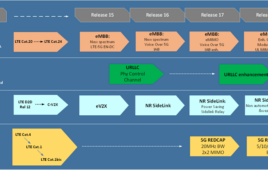We are beginning an era marked by tremendous global growth in mobile data subscribers and traffic. In fact, Infonetics Research forecasts that mobile data subscribers will grow from the 548.9 million in 2010 to a whopping 1.8 billion in 2014. Today’s mobile broadband networks must carry multiplay services that share radio access and core network resources, as well as support delay-sensitive, real-time services. What’s more, each service has different quality of service (QoS) requirements in terms of packet delay tolerance, acceptable packet loss rates and required minimum bit rates.
 As mobile networks evolve to high-speed, IP-based infrastructure, the wireless industry is busy developing and implementing QoS and policy management to ensure the high-quality services that consumers demand, all while adding network capacity. These “rules” serve several purposes – they are designed to ensure application quality, they allow operators to offer differentiated services to users, they manage network congestion, and they help to recoup the substantial sums that have been invested in building out new networks.
As mobile networks evolve to high-speed, IP-based infrastructure, the wireless industry is busy developing and implementing QoS and policy management to ensure the high-quality services that consumers demand, all while adding network capacity. These “rules” serve several purposes – they are designed to ensure application quality, they allow operators to offer differentiated services to users, they manage network congestion, and they help to recoup the substantial sums that have been invested in building out new networks.
As such, policy management will play a fundamental role in implementing QoS in mobile broadband moving forward. Defined as the process of applying operator-defined rules for resource allocation and network use, policy management is critical to three closely-related areas – limiting network congestion, enhancing service quality and monetizing services.
Limiting Congestion and Enhancing Service Quality
Adding transmission lines, fatter pipes and improving efficiency are common responses to network congestion. However, this strategy works better for wired networks than for wireless networks. While increasing capacity with additional spectrum and improving spectrum efficiency are important, capacity improvements alone will not solve this complex challenge.

We all know that mobile operators do not have unlimited resources and capital. Providing high service quality by over-provisioning network capacity will eventually leave an operator at a competitive disadvantage to providers that offer the same or better QoS at a lower cost. A solid policy strategy requires that network performance is maintained during peak traffic times and spikes in user demand, which saves the operator from having to carry excess capacity. With a mixture of proactive management policies and other strategies like network offloading and demand calibration, mobile broadband networks with finite resources can better satisfy consumers’ demand for multiplay services. Policy management differentiates services (applications) and subscriber types, and then controls the quality of experience (QoE) of each type.
Policy management also allows operators to granularly control the availability and QoE of different services. First, policies are used to dynamically allocate network resources – for example, a particular bandwidth can be reserved in the radio base station and core network to support a live video conversation. Policy rules also control the priority, packet delay and the acceptable loss of video packets in order for the network to treat the video call in a particular manner.
In other cases, policy rules might be used to limit traffic rates on the network in order to curb network abusers and provide fair use – preventing one user from negatively impacting the quality of another service. For example, peer-to-peer (P2P) file sharing is a very bandwidth-intensive, non-real-time service. P2P services, if left unmanaged, can consume a disproportionate amount of network resources and negatively impact the network’s ability to establish and maintain real-time service quality.
Service Monetization
The market landscape is rapidly changing for wireless operators. With voice-only services, operators captured the majority of the customers’ mindshare and service revenue. To the consumer, the voice-only wireless operator was viewed as an end-to-end service provider.

However, the emergence of smart devices like smartphones and tablets has blurred the line between who provides value to the subscriber and who they pay. Operators are at greater risk of becoming bit transporters, while content/application providers and device manufacturers capture more of the revenue from mobile subscribers. Operators can look to policy management as a way to form new business models and maximize service monetization. It helps to retain subscriber mindshare and dollars by allowing granular control of service quality. By having policy control, operators can meet service expectations through network performance modulation, and thereby guarantee customer QoE and limit subscriber churn.
Policy management can also be taken a step further toward the creation of new business models by offering tiered service levels. Tiered service levels can guarantee superior performance and quality to higher paying subscribers like corporate accounts, for example. These levels can be purchased via subscription or instant demand. So a subscriber can upgrade their service for a fixed period of time to watch their favorite football team play in high definition. By improving the content delivery quality for fixed periods, policy control supports subscribers’ impulse buying of premium services.
This type of end-to-end network flexibility and service quality control can potentially lead to revenue-sharing agreements with third-party content providers and application content vendors. Operators can form strong relationships with content providers based on excellent service delivery – barring any government regulation preventing tiered service, such as the United States’ “net neutrality” policy.
Phasing-In Policy Management
Operators will likely take a phased approach in adding policy management to their networks, starting with congestion reduction for applications such as P2P services. Aggregate-level policy may also be introduced in the first phases. Due to its complexity, operators are not likely to implement per-subscriber policy management implemented. However, as the technology matures, traffic congestion continues to increase, and competitive pressures mount, QoS and policy management will become increasingly important. To prepare, operators must make sure they are working with vendors that have a strong framework to supply end-to-end QoS and are capable of supporting evolving needs.
Service Quality Validation for Mobile Broadband
While operators work on phasing in policy management, they are also spending billions of dollars on equipment, spectrum and deployments to upgrade their mobile broadband networks. As they make these decisions, they must carefully evaluate the capacity and performance capabilities of the products they are considering for deployment. After selecting a vendor, network designs should be prototyped in the lab prior to deployments. As new hardware, firmware or services are introduced, they should be thoroughly evaluated for performance and it must be verified that they do not negatively impact the performance of existing network services.
Service quality validation allows operators to evaluate networking devices and proactively measure their QoS and policy management functions. Service-quality validation of wireless networks requires saturating the network with a high load of real-world subscriber traffic through mobile subscriber modeling and by measuring KPIs that identify QoE. The fundamental strategy is to test the mobile data network with the traffic types and traffic mixes that most closely resemble the real services that operators will deploy. Service quality and policy/QoS schemes are only stressed when a network encounters congestion. The test approach should involve fully loading the device or system under test (DUT/SUT). After a network is fully loaded with a broad mix of real traffic services, detailed QoE measurements are made to quantify network performance. Comprehensive service quality validation arms network equipment manufacturers (NEMs) and operators with a solid method to quickly evaluate the quality and performance of devices and networks.
Mobile Subscriber Modeling
Mobile subscriber modeling is a pillar of any service quality validation strategy. It is the process of defining subscriber types (for example, corporate user vs. casual user), associating applications to a subscriber (such as Internet browsing, email, voice, video and P2P), and modeling subscribers’ usage of applications and their mobility on the network. Subscriber modeling allows testers to replicate real traffic types and usage patterns and provides the information necessary to fully understand the capacity limits of the network, how multiplay services interact with one another and the network’s ability to differentiate services and subscriber types. Subscriber modeling requires very granular control of service/subscriber emulation.
Figure 3 shows an example of how a causal subscriber might use the network. The subscriber may use the web browser on their smartphone to browse to a website using a URL. The user pauses to read the website, and after a certain amount of time clicks on a link to an interesting blog article. While reading the article, the causal user downloads an embedded YouTube video and watches a video clip for 1 minute. Once the video is finished, she might call a friend to discuss the blog and video they just watched.

This is a common multiplay scenario carried out by millions of mobile data subscribers every day. Testers need the ability to quickly define specific traffic models in a matter of minutes instead of hours or days. An intelligent application-level user interface is required. The associated mobility protocols for network attachment, security authentication and bearer establishment also must be emulated. To be effective and emulate a wide and varying degree of application services, the test system must not force the user to be an expert at the underlying protocol procedures.
After modeling the behavior of a specific mobile subscriber, the next step is to place them in a group of like subscribers and model usage over time. This emulates the behavior patterns of different categories of subscribers, such as business users, casual users and telecommuters. Another interesting component is that traffic usage changes significantly by the time of day, which you can see in Figure 5.
Subscribers’ application-use is rapidly evolving, and the distribution varies greatly by user type. The key point is flexibility. No one can predict exact usage out into the distant future as new applications emerge and become popular. A test frame work must be highly adaptive to future trends.

However, successful testing in the lab using controlled and small volumes of traffic does not guarantee success in the field. Policy/QoS mechanisms must be measured using high volumes of emulated subscriber traffic when a network or node is at or near capacity, which involves generating millions of concurrent web transactions and transactions per second.
The wireless core network is the aggregation point for wireless access network traffic. A core network is called on to terminate the traffic originating from millions of mobile subscribers across thousands of radio base stations. Today’s baseline for testing the wireless core is over 100 Gbps of stateful traffic – this will evolve to terabits of data as mobile broadband takes off.
KPIs for QoE in Multiplay Wireless Networks
QoE is a measure of the overall level of customer satisfaction with a service. Quantitatively measuring QoE requires an understanding of the KPIs that impact users’ perception of quality. KPIs are unique by service type. Each service type, such as conversational video, voice and Internet browsing, has unique performance indicators that must be independently measured.
To fully understand QoE, KPIs must be evaluated over time, at varying load rates and application mixes. Policy and QoS mechanisms must be judged when a network is fully loaded and there are competing demands for network resources. Only under these conditions can the effectiveness of rate limiting/policing, packet shaping, resource scheduling and packet delay budgets be thoroughly analyzed and tuned.
Use Case: Tier One operator preparing LTE network to handle voice using VoLTE
One of the world’s premier Tier One operators is equipping its LTE network to handle IP-based voice services. As will most operators, it will first support voice services on LTE handsets using their existing 3G network. Circuit-switched fallback will split voice and data traffic between the 3G and LTE networks, carrying only data on the LTE network. By implementing voice over LTE (VoLTE), the operator can use its packet-based LTE network for voice service and more cost-effectively grow its bandwidth and flatten the network architecture to a single IP-based network. But before this deployment can occur, the operator must have high confidence that voice, data and video traffic can be carried simultaneously with high service quality, ensuring that one service does not negatively impact another.
With actual service turn-up planned in the future, the operator is ramping up its lab. The test lab includes LTE radio base stations, switches, routers, S-GW/PDN-GW, policy server, IP multimedia subsystem (IMS) core network, and other equipment to fully replicate their production network. It should contain test equipment to “sandbox” different scenarios to validate the network’s ability to support VoLTE using IMS-based VoIP. To properly handle converged multiplay traffic, the network must be capable of giving the operator granular control of QoS/QoE for each type of service. This can only be done by properly implementing standards for policy and charging control.
Planning today for the future network
The mobile data revolution is pushing operators worldwide to add new services and more powerful devices. Simultaneously, they are making substantial investments to upgrade the capacity and performance of their networks so that they can generate money from sophisticated data services instead of voice traffic.
However, the economic realities and physical limitations of available spectrum prevent operators from simply adding more and more network capacity. Instead, they should maximize the revenue generated from their services. In order to achieve this, new business models and more premium services must be adopted. In turn, as subscribers receive more services that cost more money, their expectations of acceptable network availability and quality will ratchet up. Operators must plan today for the future evolution of the network, which means working with vendors that have a solid roadmap for QoS and policy mechanisms in their products.
Mobile subscriber modeling and multiplay service emulation are fundamental parts of measuring QoS, policy mechanisms and QoE. They are mission-critical techniques that allow equipment vendors and mobile operators to measure today’s network and device performance, as well as adapt to new services and capabilities mobile data networks evolve.
Joe Zeto is senior manager, Market Development, for Ixia.




